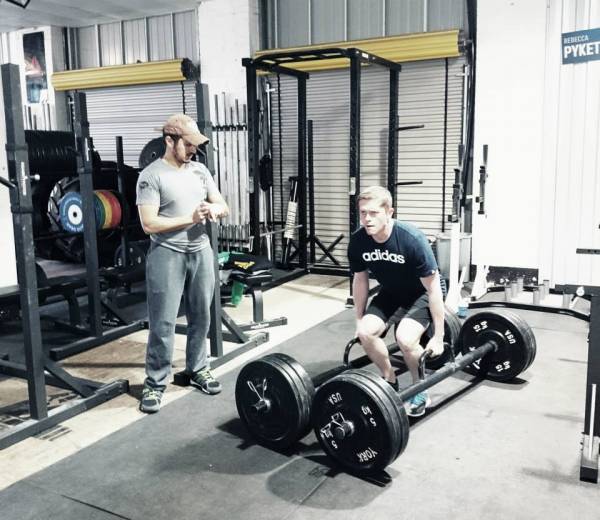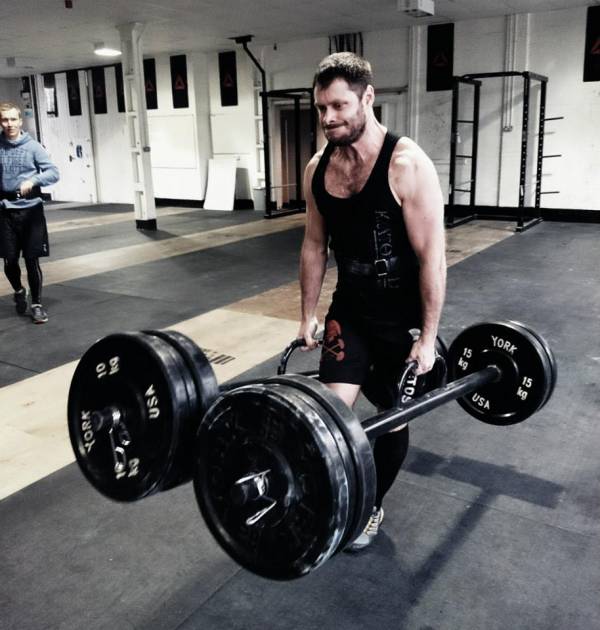Click Here to Try Our Free Strongman Workouts
Want to take your training to the next level? Thought you might. What if I told you it was as simple as picking up a couple of heavy objects and walking with them? It’s true.
The farmer’s walk is a game changer. This exercise is one of my favorite strongman events for a reason – it has serious impact on your strength and major carryover into your lifting.
Weighted Carry Movements Have Significant…Carryover
I mentioned in my previous article on the yoke that yoke carries and farmer’s walks are both weighted carries and share a few similar considerations. However, they both deserve individual insight, and this is why I have chosen to follow up my article on the yoke with one on the farmer’s walk. This piece will take a look at the basics and benefits of the farmer’s walk, along with typical events and how to train for them. I’ve also put together some standards for you to aim for, along with technique tips to get you there.
The Farmer’s Walk: Introduction
When doing farmer’s walks strongman-style, you use a piece of equipment comprised of a pair of thick metal bars with handles in the middle. This allows you to carry the bars and gives you the ability to load weights onto each end.
Broadly speaking, there are two different styles of equipment used: one where the weight plates are loaded onto the ends of the bars so the plates rest on the floor and another where the weight is loaded on top. The lengths of metal are flat like girders rather than traditional bars, and are easier to work with than bars, as they don’t roll away when you place them on the floor.
The other variables involved in farmer’s walks are the handle sizes of the equipment (a thicker handle being harder to grip) and the length of the walks you execute (longer being more unstable).
Benefits of the Farmer’s Walk
Dan John stated that, “The loaded carry does more to expand athletic qualities than any other single thing I’ve attempted in my career as a coach and an athlete.” And that’s some statement considering his experience. Moreover, Dan refers to the farmer’s walk as the “King of Carries.” This gives you an idea of the width and depth of benefits that farmer’s walks provide. Not all of these benefits can be described in muscular terms, but if we are going to do so, we are looking at developing powerful legs and hips, strength through the core, a strong and stable back, and of course, phenomenal grip strength, to name just a few.
Typical Events
Typical farmer’s walk events you may encounter are:
- Max distance covered in 60 seconds (scored by distance)
- A single timed run of anything from 10 meters up to 40 meters (scored by time)
- A medley of farmer’s walk mixed in with other carries or events (scored by time)

How to Train
Increasing the maximum amount of weight you can pick up off the ground is both fun and useful. However, it’s not necessarily the most effective way of training this movement – at least, not all the time. In actuality, you won’t train the farmer’s walk much differently than you train the yoke. This makes sense considering the events you will likely encounter are similar. I would generally rotate your training around these three types of training days:
- Light weight and long distance (40-60m)
- Mid weight and mid distance (20-30m)
- Heavy weight and short distance (10-15m)
Remember, progress doesn’t just come in the shape of weight plates. It can also take the form of a measuring tape (distance) or a stopwatch (timed runs or rest periods.) The objective is to carry weight over a long distance quickly. A heavier weight, a longer distance, quicker time, or a combination of these is all ways to progress. And ideally, you want to increase them all – carrying a heavier weight over a longer distance, faster.
Every once in a while, if training is feeling exceptionally good, then turn up the heat and keep adding weight over a set distance. But remember, this is not an excuse to turn all your light sessions into heavy ones. This is an exclusive, one time admittance ticket to maxing out when it’s all working well.
Consider the opposite, too – carrying a set weight as far as you can until you fail. This can be an odd thought, as you know before you start that you are going to fail. This approach is invaluable not only for physical fortitude when your body is screaming at you, but also for mental tenacity when you mind is struggling with the concept and the task.
Strength Standards
Considering that the farmer’s walk is initiated by picking something off the ground, the obvious reference point for most people is the deadlift. However, don’t let this limit you. It’s likely you’ll be able to pick up and walk with more than you can deadlift. I believe that 0.75 x bodyweight in each hand is a good starting point for both men and women. Bodyweight in each hand is a great aim and very achievable. Being able to do 1.25 x bodyweight will put you well above the majority into advanced territory, and 1.5 is exceptional.
It works the other way, too. After not only picking up but also walking with weights like these, heavy deadlifts and other such pulls are put into perspective. I’ve seen sessions like this give clients a whole new lease on life with a host of other lifts in the gym, like they are realizing their own strength.

Technique Tips For The Farmer’s Carry
Center yourself – Although it might be tempting to “grip it and rip it,” especially when the event is just a single short run of ten to fifteen meters, make sure your hands are central on the grip. Being a little out of position with the hands can translate into the weights tipping forward or backward substantially. At best, this will tire your grip as you try and get balanced. At worst, one side of one or both of the walks will hit the floor and bring you to a dead halt.
Get solid – Once you center yourself, get solid through your whole body. Squeeze the glutes and brace the core. Get the chest up and sit your weight through the heels. Drive through the floor to pick up the weight. If you pick the handles up in a disadvantaged position, then you’ll be at a disadvantage throughout.
Get tall and straight – Get tall by standing up, making sure the hips are open and the shoulders are pinned back. Get straight by making sure standing does not end up looking like hyperextension through the back. Squeeze the glutes and tuck your ribcage in to straighten up. Look straight ahead.
Small, fast steps – Taking small steps will help to stop the equipment from swinging by your side. I often get my clients to warm up with quick heel-to-toe walks, just to get them used to shortening their stride. But small doesn’t mean slow. Move the feet quickly!
Drop carefully – Make a judgement call depending on the type of event you are in and the type of farmer’s walk handles you have. When you get to the end of your run – with your shoulders burning, arms about to fall off, and grip about to give – the overwhelming urge is to just drop the equipment. However, if you have to turn around and pick everything up again, taking a second to put the bars down under control so they are in a good and even position to pick up again could be time and effort well spent.
The Farmer’s Walk: Summary
The farmer’s walk is well worth adding to your repertoire. It may well be the missing link in your training. Do me a favor – actually, do yourself a favor – and include it in your training once a week for the next six to ten weeks. Let me know how you progress, not just with your farmer’s walks, but with everything else, too. Feel free to post up links to pictures and videos below!
Click Here to Try Our Free Strongman Workouts
References:
1. John, D., “The Secret of Loaded Carries.” T-Nation, accessed 26 March, 2014.
Photos courtesy of Strength Education.






